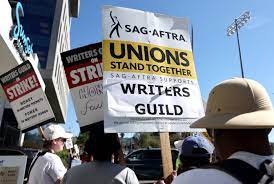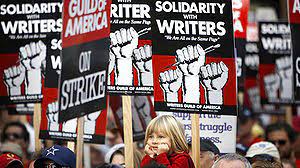We’re into the second half of July. The striking arts workers who are members of the Writers’ Guild of America (WGA) continue their strike, and have been joined by members of The Screen Actors Guild and the American Federation of Television and Radio Artists (SAG/AFTRA).
I thought I’d take a little time to gather some information to share with others who haven’t had the chance to inform themselves of what is going on.
The issues include fair pay and compensation, ending labor exploitation and labor theft, the threats presented by AI, and the tremendous wealth created by digital streaming that is not shared by those who “own” the delivery platforms with those who wrote and performed and created the work feeding that bonanza. Here is a good breakdown of the issues.
Attitude among “regular” people (is there really such a thing?), who daily partake of the art created by these individuals, sometimes leans towards resentment: What are they complaining about? They get to work in a great industry, don’t they? They get to rub shoulders with celebrities and famous artists, right? They want glamour AND fair pay? They probably already make 100x what I earn as a (fill in the blank). The truth is that so few of us in this country earn a living wage that it is mind-boggling. Arts workers suffer low wages in a far-reaching way that is often concealed by the perceived glamour of the industry.
The way striking workers find themselves maligned in the media hasn’t changed in generations. The narrative usually shapes around things like this: The workers are already spoiled, already over-demanding, already getting more than their fair share and are being unreasonable. They should be grateful for the opportunities provided to them. Others would happily take their place and keep their mouths shut except to express that gratitude.
Well, the realities are not to be found in the illusions created by the executives of the corporations and production companies and streaming services.
Marissa Messiano informs us who the Writers Guild of America is:
“The Writer’s Guild of America (WGA) was first founded in 1933, and almost all television and film writers (along with writers of some scripted podcasts and other digital media) are members of the WGA. It’s the WGA’s Basic Agreement contract that writers work under.”
She also explains who the writers are striking against: “On the other side of the negotiation table is The Alliance of Motion Picture and Television Producers (AMPTP), a group that represents over 350 production companies in the country, including Warner Bros. Entertainment, Universal Studios, Paramount, Netflix, Walt Disney Studios, Amazon, Sony, and many others.”
What is the Writers Guild of America demanding? Read the document here.
Messiano says, “There are a few themes within the writer’s requests that led to the WGA strike: asking for better pay and stability for writers, restricting the use of artificial intelligence in writing, and improving pay and residuals for streaming content – something that has significantly fallen behind since the introduction of streaming.”
You can read Messiano’s whole article, which details the reasons for the requests that WGA is making here.
You can read more about this strike and its issues here, in an article by Jess Weatherbed.
Some of what she writes, “The companies’ behavior has created a gig economy inside a union workforce, and their immovable stance in this negotiation has betrayed a commitment to further devaluing the profession of writing,” said the WGA West on Monday. “From their refusal to guarantee any level of weekly employment in episodic television, to the creation of a ‘day rate’ in comedy variety, to their stonewalling on free work for screenwriters and on AI for all writers, they have closed the door on their labor force and opened the door to writing as an entirely freelance profession. No such deal could ever be contemplated by this membership.”
What about the SAG/AFTRA strike? First, it is the first time in over 60 years that this combined union has struck their industries. James Poniewozik, TV Critic for the NYT, writes about it here
He identifies that big problem about narrative I spoke about above: “SAG-AFTRA, the union representing TV and film actors, joined the writers in a walkout over how Hollywood divvies up the cash in the streaming era and how humans can thrive in the artificial-intelligence era. With that star power comes an easy cheap shot: Why should anybody care about a bunch of privileged elites whining about a dream job?”
Poniewozik points out what most of us who have faced labor exploitation already know: that the “star system” of high pay for a few holds the majority of workers in all occupations at poverty levels of income. In the SAG/AFTRA story, those poverty workers are the background actors. “The lower-paid actors who make up the vast bulk of the profession are facing simple dollars-and-cents threats to their livelihoods. They’re trying to maintain their income amid the vanishing of residual payments, as streaming has shortened TV seasons and decimated the syndication model. They’re seeking guardrails against A.I. encroaching on their jobs.There’s also a particular, chilling question on the table: Who owns a performer’s face? Background actors are seeking protections and better compensation in the practice of scanning their images for digital reuse.” And, by “reuse” the issue is how, or if, an actor’s image can be scanned and used into perpetuity for a single day’s pay. And what do background actors make for a day’s work? As of July 2023, the average hourly pay for a background actor’s work is $12.63/hour.
Bottom line, these jobs have been turned into gig jobs in unsustainable ways for human beings, and now there is the threat of AI digitizing and, essentially, stealing the writing, the images, the being-ness of all of these artists and their work.
Fran Drescher, the current president of SAG/AFTRA made a speech that has gone viral. In explanation of the strike, she makes the point that all workers, across all disciplines and occupations are facing the same exact kinds of “unpay” and exploitation, unsustainable compensation, lack of living wages. Here is the text of what Dresher said.
Here is a video of her speech.
Lest any of us think that the more high-profile actors face little hardship, the internet offers plenty of other stories from actors about their financial realities. In an interview with Bethy Squires, Kimiko Glenn talks about how many of the actors on “Orange is the New Black” continued to have “day jobs” and “side gigs” even at the height of the show’s success.
According to Glenn, most of the actors on the show, even at a point when they were internationally famous, still couldn’t afford to take a cab to set, still held down jobs like bartending. Can we all admit that this is absolutely insane?
The decision to strike is never made easily. It actually creates more hardship while the works are fighting for better circumstances. This is especially true when part of the strategy of the opposite side is to drag out negotiations and starve out the already-underpaid strikers. What does the strike mean for actors? What is required, and what is prohibited? Andrew Dalton explains in his article.
The strike rules go far beyond “acting”. “They are not allowed to make personal appearances or promote their work on podcasts or at premieres. They are barred from doing any production work including auditions, readings, rehearsals, voiceovers or wardrobe fittings. Newly minted Emmy nominees can’t publicly make their case for votes, nor appear at the ceremony, which is planned for September but is likely to be seriously scaled back or delayed.
They are instead expected to spend their days on picket lines, outside the corporate headquarters and production hubs of studios. This is no vacation.
How does this combined strike impact the industry? And how will the viewers experience the strike’s impact? Dalton says, “Actors joining writers on strike will force nearly every U.S.-based show or film that hasn’t already been shut down into hiatus. Upcoming shows are likely to be delayed indefinitely, and some movie releases will pushed back.” Where the writers’ strike had something more like an immediate effect on late-night and comedy programs, it may take a while longer to see the impact on scripted television series. Production has been shut down on some shows, like “Stranger Things,” “Hacks,” or “Yellow Jackets.” Release dates have been pushed back or placed on hold for series and movies and shows.
So, given the way the writers and actors and other industry professionals are being treated, how do WE, the people who pay for streaming content, buy movie tickets, watch TV and movies and series support the people without whom there would BE no TV, movies and series? Should we be boycotting movie theatres, cancelling our streaming? Not yet, we’re told. This is not yet seen as “crossing a picket line”
Narrowing that question a bit, how do we artists, working in publishing, teaching creative writing or screenwriting or filmmaking respond? How do artists in ALL disciplines respond? We certainly can identify with the struggles created by the ever-increasing power inequalities between the artists and the owners of the delivery platforms/spaces — whether that is a music streaming platform, a gallery system, publishing inequalities, academic gig-i-fication — Are any of us receiving living wages? How do we support our fellow artists? I suggest that it is time for us to amp up the ways and places where we share information about these strikes. We can use our own social media sites to “speak” in support and to share the truth about the struggles. We can even use our professional membership organizations to speak in support of these strikes.
I would suggest that we ALL be prepared to join the strike, because there may be a time when our efforts have to be gathered and added to this fight. We may reach a point when our solidarity with these artists has to be brought to bear. We can exert enormous pressure on the powerful studios with our own consolidated actions in order to make our own voices heard, in order to join a fight that, as Fran Dresher said, is a fight that connects all workers, all those who have suffered exploitation. None of us can afford to see this strike action fail.






